

The Kipling method. Purpose.
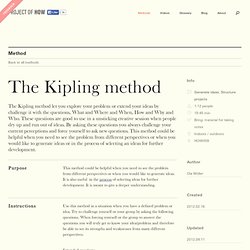
Empathy Map. An empathy map is a collaborative tool teams can use to gain a deeper insight into their customers.
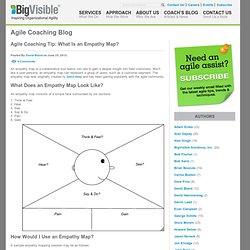
Much like a user persona, an empathy map can represent a group of users, such as a customer segment. The empathy map was originally created by Dave Gray and has been gaining popularity with the agile community. Mrs Potters Questions. The SOARA process. #589 Innovative Leader Volume 12, Number 11 November 2003 Integrative Thinking by Graham Douglas Graham Douglas is a consultant in Integrative Thinking and author of The Revolution of Minds!
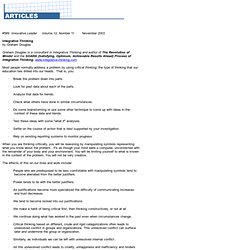
And the SOARA (Satisfying, Optimum, Achievable Results Ahead) Process of Integrative Thinking. www.integrative-thinking.com. Most people normally address a problem by using critical thinking; the type of thinking that our education has drilled into our heads. That is, you: · Break the problem down into parts. · Look for past data about each of the parts. · Analyze that data for trends. · Check what others have done in similar circumstances. · Do some brainstorming or use some other technique to come up with ideas in the context of these data and trends. SEAHORSE. SCAMPER. The SCAMPER technique (created by Michael Mikalko), will assist you in thinking of changes you can make to an existing product to create a new one via a checklist, these can either be used directly or as starting points for lateral thinking.

SCAMPER is an acronym which stands for questions relating to the following: S - Substitute - components, materials, people Think about substituting part of your product/process for something else. By looking for something to substitute you can often come up with new ideas C - Combine - mix, combine with other assemblies or services, integrate Think about combining two or more parts of your probortunity to achieve a different product/process or to enhance synergy. A - Adapt - alter, change function, use part of another element Think about which parts of the product/process could be adapted to remove the probortunity or think how you could change the nature of the product/process.
Perceptual Maps/Positioning Maps. Introduction Firms use perceptual or positioning maps to help them develop a market positioning strategy for their product or service.
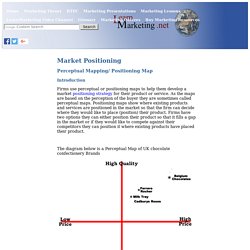
As the maps are based on the perception of the buyer they are sometimes called perceptual maps. Positioning maps show where existing products and services are positioned in the market so that the firm can decide where they would like to place (position) their product. Firms have two options they can either position their product so that it fills a gap in the market or if they would like to compete against their competitors they can position it where existing products have placed their product. The diagram below is a Perceptual Map of UK chocolate confectionery Brands Drawing a Perceptual (Positioning) Map Theoretically a perceptual map can have any number of lines, to keep things simple they usually have 2 lines the x and y axis. Example Perceptual Map In the example below two dimensions price and quality have been used. Lotus Blossom Approach. We were all born as spontaneous, creative thinkers.
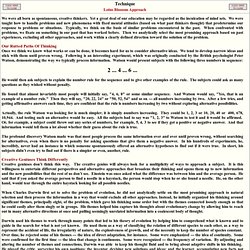
Yet a great deal of our education may be regarded as the inculcation of mind sets. We were taught how to handle problems and new phenomena with fixed mental attitudes (based on what past thinkers thought) that predetermine our response to problems or situations. Typically, we think on the basis of similar problems encountered in the past. When confronted with problems, we fixate on something in our past that has worked before.
Then we analytically select the most promising approach based on past experiences, excluding all other approaches, and work within a clearly defined direction toward the solution of the problem. Our Rutted Paths Of Thinking Once we think we know what works or can be done, it becomes hard for us to consider alternative ideas. He would then ask subjects to explain the number rule for the sequence and to give other examples of the rule. DATT™ This site takes advantage of cutting edge technology to present the most effective and efficient website.
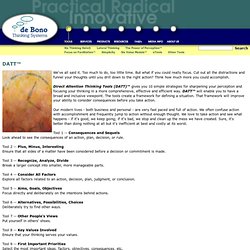
This technology requires that your browser supports web standards. While this site will remain functional for you without, we strongly recommend you upgrade to a standards-compliant browser. We've all said it. Too much to do, too little time. But what if you could really focus. Direct Attention Thinking Tools (DATT)™ gives you 10 simple strategies for sharpening your perception and focusing your thinking in a more comprehensive, effective and efficient way.
Our modern lives - both business and personal - are very fast paced and full of action. Tool 1 -- Consequences and Sequels Look ahead to see the consequences of an action, plan, decision, or rule. Tool 2 -- Plus, Minus, Interesting Ensure that all sides of a matter have been considered before a decision or commitment is made. Tool 3 -- Recognize, Analyze, Divide Break a larger concept into smaller, more manageable parts. The Thinking Sandwich. This is a mental management strategy.
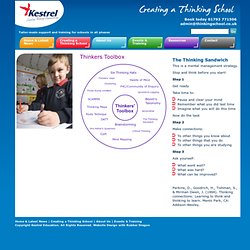
Stop and think before you start! Step 1 Get ready Take time to: Pause and clear your mind Remember what you did last time Imagine what you will do this time Now do the task Step 2 Make connections: Thinkers' Keys. First developed by Tony Ryan, Thinker's Keys are a set of twenty different activities designed to engage and motivate learners in a range of thinking tasks.
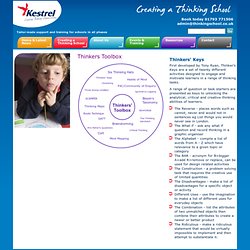
A range of question or task starters are presented as keys to unlocking the analytical, critical and creative thinking abilities of learners. The Reverse - places words such as cannot, never and would not in sentences eg List things you would never see in London.